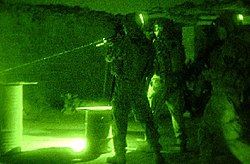This article has multiple issues. Please help improve it or discuss these issues on the talk page. (Learn how and when to remove these messages)
|
| Operation Phantom Thunder | |||||||
|---|---|---|---|---|---|---|---|
| Part of the Iraq War | |||||||
 An American soldier fires an AT4 in the Adhamiyah neighborhood. | |||||||
| |||||||
| Belligerents | |||||||
|
|
Other Iraqi insurgents | ||||||
| Commanders and leaders | |||||||
|
|
| ||||||
| Strength | |||||||
|
~28,000 U.S./Iraqi Forces | Unknown | ||||||
| Casualties and losses | |||||||
|
1 OH-58 Kiowa and 1 AH-64 Apache shot down |
1,196 killed (46 bombers), 6,702 captured, 51 boats destroyed, 1,113 weapons caches destroyed, 382 high value individuals captured or killed, 2,299 IEDs cleared, 52 VBIEDS neutralized, 142 total Battalion-level Joint Operations[4][5][6][7] | ||||||

Operation Phantom Thunder began on 16 June 2007, when Multi-National Force-Iraq launched major offensive operations against al-Qaeda and other extremist terrorists operating throughout Iraq. It was the largest coordinated military operation since the 2003 invasion of Iraq.[8] Operation Phantom Thunder was a corps level operation, including Operation Arrowhead Ripper in Diyala Province, Operation Marne Torch and Operation Commando Eagle in Babil Province, Operation Fardh al-Qanoon in Baghdad, Operation Alljah in Anbar Province, and continuing special forces actions against the Mahdi Army in southern Iraq and against Al-Qaeda leadership throughout the country.[9] The operation was one of the biggest military operations in Iraq since the U.S. invasion in 2003.[10]
- ^ "The Battle of Baqubah I". The Long War Journal. Archived from the original on 21 June 2007. Retrieved 20 June 2007.
- ^ Michael Yon. "Be Not Afraid". Archived from the original on 11 March 2008. Retrieved 20 June 2007.
- ^ "The Progress of the Peshmerga Forces and their role in post-2003 Iraq. BySaeed Kakeyi".
- ^ a b "Report: Sunnis attack village near Baghdad". USA Today. 10 July 2007.
- ^ "One Week of Operation Phantom Thunder". The Long War Journal. Archived from the original on 16 July 2007. Retrieved 23 June 2007.
- ^ "اخبار العراق اليوم من السومرية نيوز". Archived from the original on 1 October 2011. Retrieved 25 June 2007.
- ^ "mnf-iraq.com". Archived from the original on 13 July 2007.
- ^ "Institute for the Study of War". Institute for the Study of War. Retrieved 12 January 2024.
- ^ Current Press Releases - MISSING SOLDIERS RECOVERED Archived 8 October 2007 at the Wayback Machine
- ^ Yates, Dean (21 June 2007). "10,000 US troops launch major offensive in Iraq". The New Zealand Herald. Reuters. Retrieved 1 November 2011.